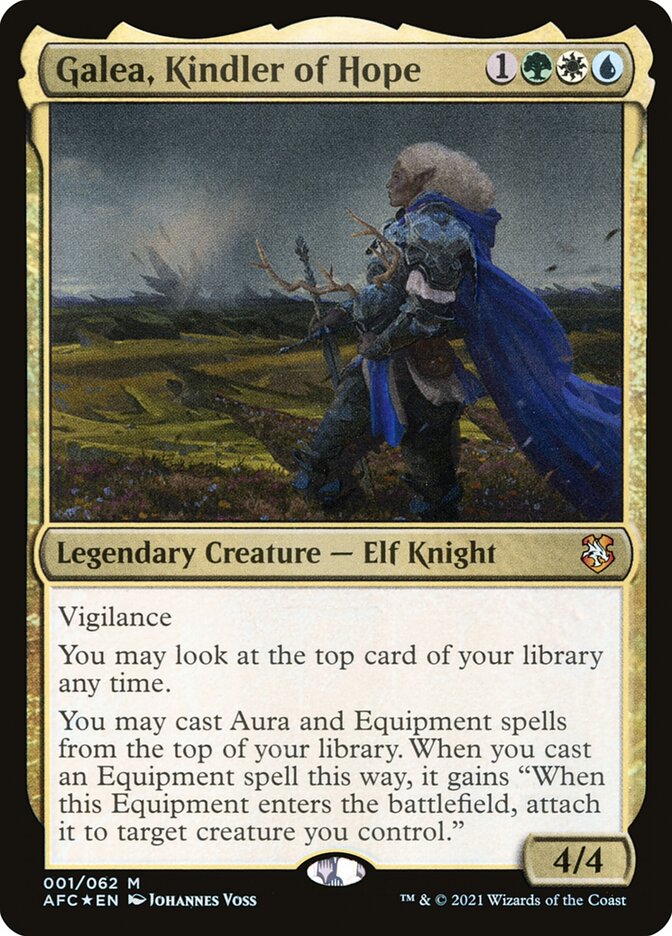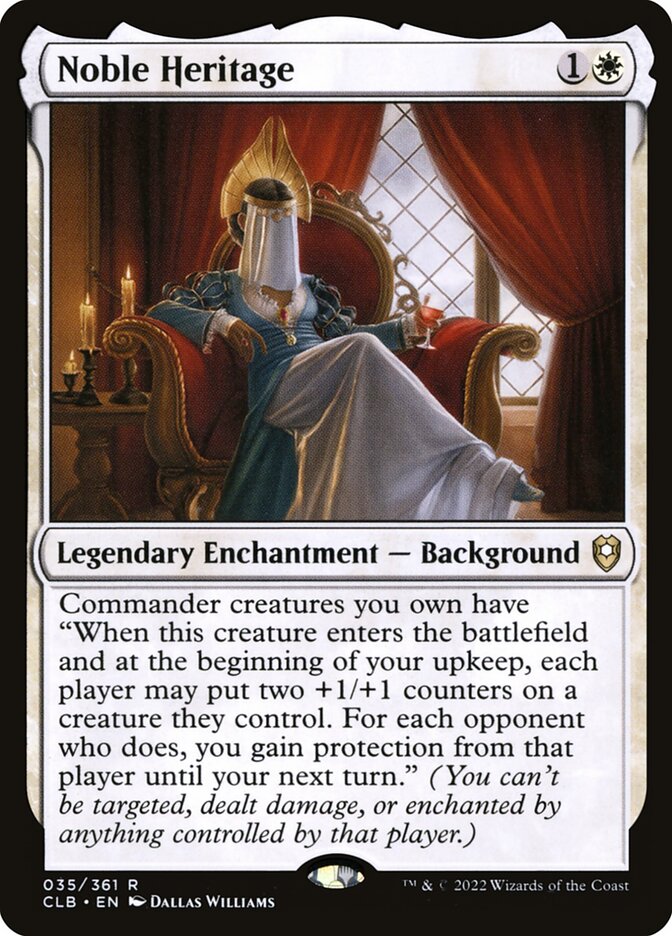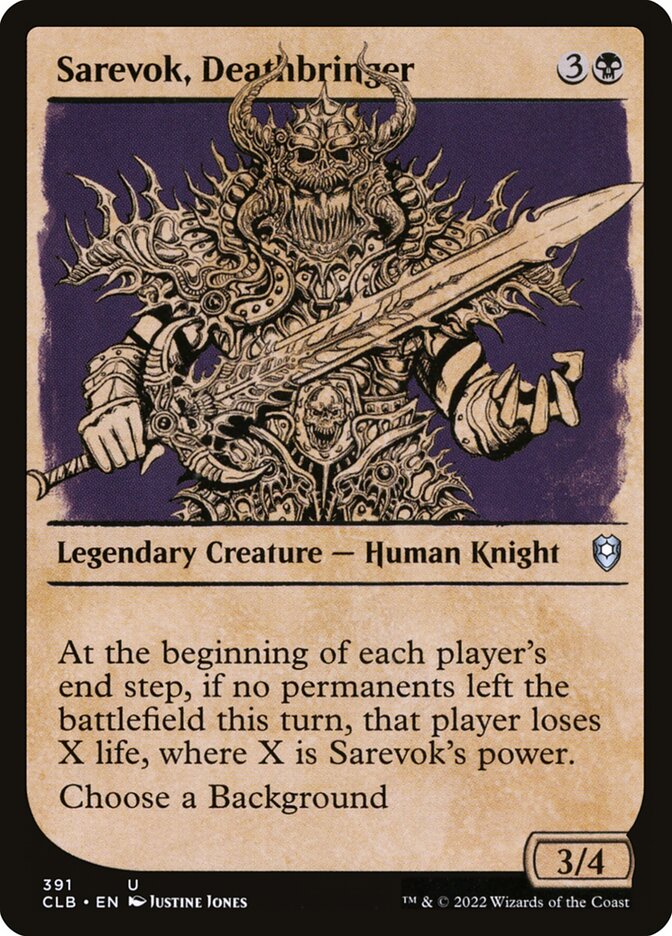Welcome to the Monday longform post! Hope you had a great weekend. This week, I wanted to talk a little more about some lessons I’ve learned while building a series of Knight decks.
Background
So, I built three different knight commanders: Galea, Kindler of Hope, Haytham Kenway, and Sarevok, Deathbringer, with the Noble Heritage Background. For each of these commanders, I’d like to share a lesson and a decklist for the latter two. You’ll learn swiftly why I only have two decklists after Galea’s lesson:
Lesson 1: Your Commander doesn’t have to encapsulate your strategy
As I was building Galea, Kindler of Hope, I realized that there was so much Galea could do for a deck built around her.
I wanted to build a deck that juggled the several themes I liked about Galea: topdeck strategies, auto-equipping equipment, knight synergies, and fun auras. It was possible to build a deck that included these three strategies, but whenever I tested the deck, I never had all the pieces of a single strategy all at once. Granted, these pieces always worked with Galea, but if she got removed, then the deck fumbled.
Then, I thought I could just build a deck involving one of those strategies. But whenever I played those versions, I could feel myself wishing I was playing a different deck. I decided to strip the deck down altogether, because I found myself in the same place I often do when I built around another Bant commander, Falco Spara: I was overwhelmed with options.
But then I remembered a very key lesson: your Commander doesn’t have to encapsulate your entire strategy. It doesn’t have to function with all pieces of the deck. It can serve a specific function. This led me to the next two decks and the next two lessons.
Lesson 2: Your Commander’s function doesn’t have to be essential
As I was building Saverok, Deathbringer, I struggled with picking a background. Because Saverok wants permanents to be removed on your turn, I was torn between Cultist of the Absolute, Clan Crafter, Cloakwood Hermit, and Guild Artisan, each of which either provides a sacrifice outlet or fodder to be sacrificed. Far Traveler was also on the table, but Blink didn’t feel right to me. It felt like a loophole to Sarevok that was boring. I prefer my Commander decks to have some element of risk, and I knew the only way I could do that well was by balancing it with a reward of some kind. High Risk, High Reward, they say.
That’s why I decided to go with Noble Heritage.
What I found compelling about Noble Heritage was that it allowed me to pursue Blink strategies if I wanted, without making it a necessary condition. I personally find Blink a little overwhelming to play because it provides a lot of opportunities to miss triggers, and I knew Sarevok’s ability would have me working hard to ensure whether or not a permanent left the battlefield this turn.
Instead, I built the Sarevok deck to focus on increasing his power and granting one-time outlets for him to remove permanents from the field. Cards like Westfield Rider remove themselves for a key function (removal) and are thus automatically included because they share the Knight synergy.
I keep saying this phrase: Knight synergy. What I mean by this is that there is a certain flavor to Knight cards and their mechanics that establishes a “fair fight”. For example, Sarevok does this by eliminating the restraint to remove something on your side of the field. If you can eliminate a creature through combat, the ability will not trigger on your turn. Other knights have great effects, but typically need to be on the field at a minimum to reap the rewards; others require that the creature attacks or deals damage. This is not necessarily a unique mechanic type, but I think building a deck around creatures with these sorts of effects.
That said, I’ve talked a lot about the risk involved with Sarevok, so I think it’s time to pay attention to the rewards that Noble Heritage brings. Noble Heritage provides a typically immediate boost to Sarevok’s power when he enters the battlefield, in addition to every upkeep. This isn’t so much the reward as it technically increases risk for me, but it also increases risk for other players as well. The reward is the protection that Noble Heritage provides, specifically protection from players. This is usually a hard mechanic to come by, but it is incredibly valuable to not be damaged, enchanted, or targeted by players. But it’s also valuable to have Noble Heritage force other players to reveal how they feel about you. If you have protection from them, you probably don’t need to attack them or remove their threats. If they refuse, then you can make it difficult to evade Sarevok’s ability. Because Sarevok is growing with each turn cycle, he also provides a pretty neat attacker, but an even better blocker.
Ultimately, what I like most about Sarevok is that even though he doesn’t provide an essential function for the deck like removal or draw, the combined abilities between him and the background force the game to move at my pace.
Lesson 3: You can build decks to achieve both vibes and effects
After working on Sarevok, I wanted to build another Knight-focused deck that created the vibe of a battlefield. Specifically, I wanted that cinematic moment where you realize you have exactly what you need to succeed. Enter: Haytham Kenway.
If I decided to ever build an Esper Knights deck, I think Haytham and Sarevok would get along very well. Haytham boosts the power of other knights AND removes at least one permanent from the field. But Haytham’s appeal was having access to both effects from the Command Zone. I’ve only played one game with Haytham, but I was able to win because I encountered a common situation in MTG games: figuring out how many blocks I needed to overcome to win. I was able to win because not only does Haytham have the removal ability, but there are other creatures that either replicate this removal or make it more effective (shout out to Werefox Bodyguard and Starfield Vocalist), allowing me to sculpt the situation to be just right for my victory.
In order to create this feeling, I used a classic deckbuilding method: the 8 × 8 method. This was first developed on Tumblr, of all places, in this post > > >
You can also watch this great video by CAG member Rebell Lily:
The 8 categories I initially developed for Haytham were:
Ramp
Draw
Removal
Protection
Knights: providing anthems or discounts for Knight creatures
Openings: these cards create an opportunity, either to conduct mass removal or create a solid swing.
Power: These cards boosted the power of other creatures
Changelings: these cards are also knights :)
However, I realized that I was building the deck, I could achieve any of the functions above if I had eight cards, meaning if I included cards in multiple categories, I could allow myself to put in cards that I just wanted to play (did you know Suppressor Skyguard is a knight?) to further establish the vibe.
Hope you enjoyed this week’s longer post! I’ll see you on Friday for a card to review.




